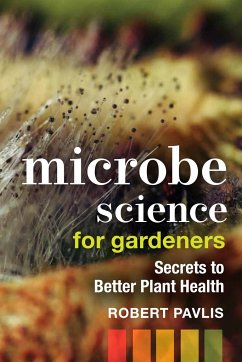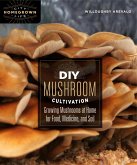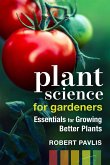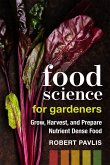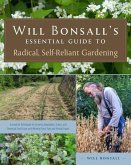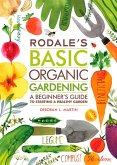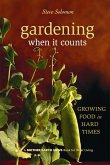24,99 €
inkl. MwSt.
Versandfertig in 2-4 Wochen

12 °P sammeln
- Broschiertes Buch
- Merkliste
- Auf die Merkliste
- Bewerten Bewerten
- Teilen
- Produkt teilen
- Produkterinnerung
- Produkterinnerung
Microscopic organisms are as important to plant growth as water and light. Microbe Science for Gardeners highlights the essential role of microbes in plant biosystems and health, provides practical how-to gardening advice for enhancing plant microbiomes and preventing disease, and debunks common gardening myths.
Andere Kunden interessierten sich auch für
![DIY Mushroom Cultivation DIY Mushroom Cultivation]() Willoughby ArevaloDIY Mushroom Cultivation30,99 €
Willoughby ArevaloDIY Mushroom Cultivation30,99 €![Plant Science for Gardeners Plant Science for Gardeners]() Robert PavlisPlant Science for Gardeners24,99 €
Robert PavlisPlant Science for Gardeners24,99 €![Food Science for Gardeners Food Science for Gardeners]() Robert PavlisFood Science for Gardeners18,99 €
Robert PavlisFood Science for Gardeners18,99 €![Will Bonsall's Essential Guide to Radical, Self-Reliant Gardening Will Bonsall's Essential Guide to Radical, Self-Reliant Gardening]() Will BonsallWill Bonsall's Essential Guide to Radical, Self-Reliant Gardening38,99 €
Will BonsallWill Bonsall's Essential Guide to Radical, Self-Reliant Gardening38,99 €![Rodale's Basic Organic Gardening: A Beginner's Guide to Starting a Healthy Garden Rodale's Basic Organic Gardening: A Beginner's Guide to Starting a Healthy Garden]() Deborah L. MartinRodale's Basic Organic Gardening: A Beginner's Guide to Starting a Healthy Garden24,99 €
Deborah L. MartinRodale's Basic Organic Gardening: A Beginner's Guide to Starting a Healthy Garden24,99 €![Gardening When It Counts Gardening When It Counts]() Steve SolomonGardening When It Counts26,99 €
Steve SolomonGardening When It Counts26,99 €![The Intelligent Gardener The Intelligent Gardener]() Steve SolomonThe Intelligent Gardener23,99 €
Steve SolomonThe Intelligent Gardener23,99 €-
-
-
Microscopic organisms are as important to plant growth as water and light. Microbe Science for Gardeners highlights the essential role of microbes in plant biosystems and health, provides practical how-to gardening advice for enhancing plant microbiomes and preventing disease, and debunks common gardening myths.
Hinweis: Dieser Artikel kann nur an eine deutsche Lieferadresse ausgeliefert werden.
Hinweis: Dieser Artikel kann nur an eine deutsche Lieferadresse ausgeliefert werden.
Produktdetails
- Produktdetails
- Garden Science Series
- Verlag: New Society Publishers
- Seitenzahl: 192
- Erscheinungstermin: 12. September 2023
- Englisch
- Abmessung: 225mm x 150mm x 14mm
- Gewicht: 308g
- ISBN-13: 9780865719774
- ISBN-10: 0865719772
- Artikelnr.: 67293208
- Herstellerkennzeichnung
- Libri GmbH
- Europaallee 1
- 36244 Bad Hersfeld
- gpsr@libri.de
- Garden Science Series
- Verlag: New Society Publishers
- Seitenzahl: 192
- Erscheinungstermin: 12. September 2023
- Englisch
- Abmessung: 225mm x 150mm x 14mm
- Gewicht: 308g
- ISBN-13: 9780865719774
- ISBN-10: 0865719772
- Artikelnr.: 67293208
- Herstellerkennzeichnung
- Libri GmbH
- Europaallee 1
- 36244 Bad Hersfeld
- gpsr@libri.de
Robert Pavlis is a chemist, Master Gardener, speaker, blogger, and owner and developer of Aspen Grove Gardens, a 6-acre botanical garden featuring 3,000 varieties of plants. His many published works include Compost Science for Gardeners, Plant Science for Gardeners, Soil Science for Gardeners, and Building Natural Ponds. He lives in Guelph, ON.
1. Introduction
Why Learn About Microbes?
Terms Used in This Book
2. The World Under a Microscope
Microbes by the Numbers
Microbes Are Important to Plants
Microbes Can Harm Plants
Gardeners Affect Microbes
How Do Microbes Move Around?
How Much Do We Really Know?
3. Bacteria
How Do Bacteria Eat?
Where Do Bacteria Live?
Life Cycle of Bacteria
Nitrogen-Fixing Bacteria
4. Fungi
What do Fungi Eat?
Where Do Fungi Live?
Life Cycle of Fungi
Pathogenic Fungi
Mycorrhizal Fungi
5. Yeast
Life Cycle of Yeast
Yeast-Plant Interactions
Yeast in Hellebore Nectar
Yeast Creates Alcoholics
Yeast on Leaves
Yeast in Soil
A Bioindicator of Air Quality
A Possible Solution to Plastic Pollution
6. Nematodes
7. Protozoa
Life Cycle of Protozoa
Nutrient Cycling
Protozoa-Plant Interactions
Plant Diseases
8. Viruses
Viruses in Soil
Life Cycle of a Virus
The Spread of Viruses
Virus Infection of Microbes
Virus Infection of Plants
Rapid Mutation
Beneficial Interaction with Plants
9. More Microbes
Archaea
Actinomycetes
Cyanobacteria
Algae
10. Microbe Communities
Microbe Communities and Microbiomes
Signaling Between Microbes
Microbes Attack Microbes
Mycorrhizal Interactions
Lichens
11. Plants Love Microbes
Nutrient Availability
The Phyllosphere
Rhizosphere
Rhizophagy Cycle
Seed Microbiome
12. Manipulating Microbes
Fungal-to-Bacterial Ratio
Effect of Agriculture
Biodiversity
13. Bioinoculants for the Garden
Bioinoculants for Seeds
Bioinoculants as a Foliar Spray
Bioinoculants for Soil
Microbes Are No Longer Living
Should Gardeners Use Commercial Bioinoculants?
Compost Tea
14. Pathogens
You Suspect a Disease-What Now?
List of Plant Diseases
Fighting Plant Diseases
Commercial Pesticides
Human Diseases
Endnotes
Index
About the Author
Also by the Author
About New Society Publishers
Why Learn About Microbes?
Terms Used in This Book
2. The World Under a Microscope
Microbes by the Numbers
Microbes Are Important to Plants
Microbes Can Harm Plants
Gardeners Affect Microbes
How Do Microbes Move Around?
How Much Do We Really Know?
3. Bacteria
How Do Bacteria Eat?
Where Do Bacteria Live?
Life Cycle of Bacteria
Nitrogen-Fixing Bacteria
4. Fungi
What do Fungi Eat?
Where Do Fungi Live?
Life Cycle of Fungi
Pathogenic Fungi
Mycorrhizal Fungi
5. Yeast
Life Cycle of Yeast
Yeast-Plant Interactions
Yeast in Hellebore Nectar
Yeast Creates Alcoholics
Yeast on Leaves
Yeast in Soil
A Bioindicator of Air Quality
A Possible Solution to Plastic Pollution
6. Nematodes
7. Protozoa
Life Cycle of Protozoa
Nutrient Cycling
Protozoa-Plant Interactions
Plant Diseases
8. Viruses
Viruses in Soil
Life Cycle of a Virus
The Spread of Viruses
Virus Infection of Microbes
Virus Infection of Plants
Rapid Mutation
Beneficial Interaction with Plants
9. More Microbes
Archaea
Actinomycetes
Cyanobacteria
Algae
10. Microbe Communities
Microbe Communities and Microbiomes
Signaling Between Microbes
Microbes Attack Microbes
Mycorrhizal Interactions
Lichens
11. Plants Love Microbes
Nutrient Availability
The Phyllosphere
Rhizosphere
Rhizophagy Cycle
Seed Microbiome
12. Manipulating Microbes
Fungal-to-Bacterial Ratio
Effect of Agriculture
Biodiversity
13. Bioinoculants for the Garden
Bioinoculants for Seeds
Bioinoculants as a Foliar Spray
Bioinoculants for Soil
Microbes Are No Longer Living
Should Gardeners Use Commercial Bioinoculants?
Compost Tea
14. Pathogens
You Suspect a Disease-What Now?
List of Plant Diseases
Fighting Plant Diseases
Commercial Pesticides
Human Diseases
Endnotes
Index
About the Author
Also by the Author
About New Society Publishers
1. Introduction
Why Learn About Microbes?
Terms Used in This Book
2. The World Under a Microscope
Microbes by the Numbers
Microbes Are Important to Plants
Microbes Can Harm Plants
Gardeners Affect Microbes
How Do Microbes Move Around?
How Much Do We Really Know?
3. Bacteria
How Do Bacteria Eat?
Where Do Bacteria Live?
Life Cycle of Bacteria
Nitrogen-Fixing Bacteria
4. Fungi
What do Fungi Eat?
Where Do Fungi Live?
Life Cycle of Fungi
Pathogenic Fungi
Mycorrhizal Fungi
5. Yeast
Life Cycle of Yeast
Yeast-Plant Interactions
Yeast in Hellebore Nectar
Yeast Creates Alcoholics
Yeast on Leaves
Yeast in Soil
A Bioindicator of Air Quality
A Possible Solution to Plastic Pollution
6. Nematodes
7. Protozoa
Life Cycle of Protozoa
Nutrient Cycling
Protozoa-Plant Interactions
Plant Diseases
8. Viruses
Viruses in Soil
Life Cycle of a Virus
The Spread of Viruses
Virus Infection of Microbes
Virus Infection of Plants
Rapid Mutation
Beneficial Interaction with Plants
9. More Microbes
Archaea
Actinomycetes
Cyanobacteria
Algae
10. Microbe Communities
Microbe Communities and Microbiomes
Signaling Between Microbes
Microbes Attack Microbes
Mycorrhizal Interactions
Lichens
11. Plants Love Microbes
Nutrient Availability
The Phyllosphere
Rhizosphere
Rhizophagy Cycle
Seed Microbiome
12. Manipulating Microbes
Fungal-to-Bacterial Ratio
Effect of Agriculture
Biodiversity
13. Bioinoculants for the Garden
Bioinoculants for Seeds
Bioinoculants as a Foliar Spray
Bioinoculants for Soil
Microbes Are No Longer Living
Should Gardeners Use Commercial Bioinoculants?
Compost Tea
14. Pathogens
You Suspect a Disease-What Now?
List of Plant Diseases
Fighting Plant Diseases
Commercial Pesticides
Human Diseases
Endnotes
Index
About the Author
Also by the Author
About New Society Publishers
Why Learn About Microbes?
Terms Used in This Book
2. The World Under a Microscope
Microbes by the Numbers
Microbes Are Important to Plants
Microbes Can Harm Plants
Gardeners Affect Microbes
How Do Microbes Move Around?
How Much Do We Really Know?
3. Bacteria
How Do Bacteria Eat?
Where Do Bacteria Live?
Life Cycle of Bacteria
Nitrogen-Fixing Bacteria
4. Fungi
What do Fungi Eat?
Where Do Fungi Live?
Life Cycle of Fungi
Pathogenic Fungi
Mycorrhizal Fungi
5. Yeast
Life Cycle of Yeast
Yeast-Plant Interactions
Yeast in Hellebore Nectar
Yeast Creates Alcoholics
Yeast on Leaves
Yeast in Soil
A Bioindicator of Air Quality
A Possible Solution to Plastic Pollution
6. Nematodes
7. Protozoa
Life Cycle of Protozoa
Nutrient Cycling
Protozoa-Plant Interactions
Plant Diseases
8. Viruses
Viruses in Soil
Life Cycle of a Virus
The Spread of Viruses
Virus Infection of Microbes
Virus Infection of Plants
Rapid Mutation
Beneficial Interaction with Plants
9. More Microbes
Archaea
Actinomycetes
Cyanobacteria
Algae
10. Microbe Communities
Microbe Communities and Microbiomes
Signaling Between Microbes
Microbes Attack Microbes
Mycorrhizal Interactions
Lichens
11. Plants Love Microbes
Nutrient Availability
The Phyllosphere
Rhizosphere
Rhizophagy Cycle
Seed Microbiome
12. Manipulating Microbes
Fungal-to-Bacterial Ratio
Effect of Agriculture
Biodiversity
13. Bioinoculants for the Garden
Bioinoculants for Seeds
Bioinoculants as a Foliar Spray
Bioinoculants for Soil
Microbes Are No Longer Living
Should Gardeners Use Commercial Bioinoculants?
Compost Tea
14. Pathogens
You Suspect a Disease-What Now?
List of Plant Diseases
Fighting Plant Diseases
Commercial Pesticides
Human Diseases
Endnotes
Index
About the Author
Also by the Author
About New Society Publishers
